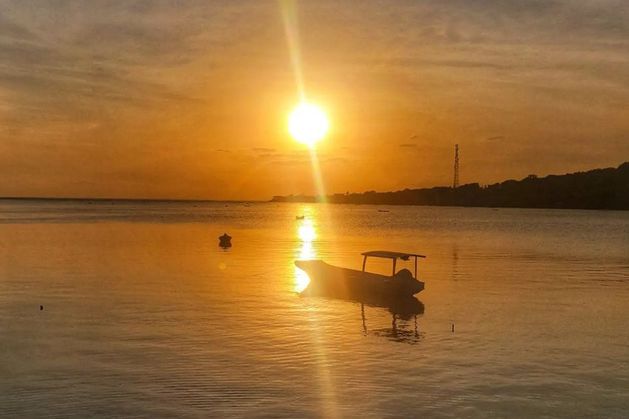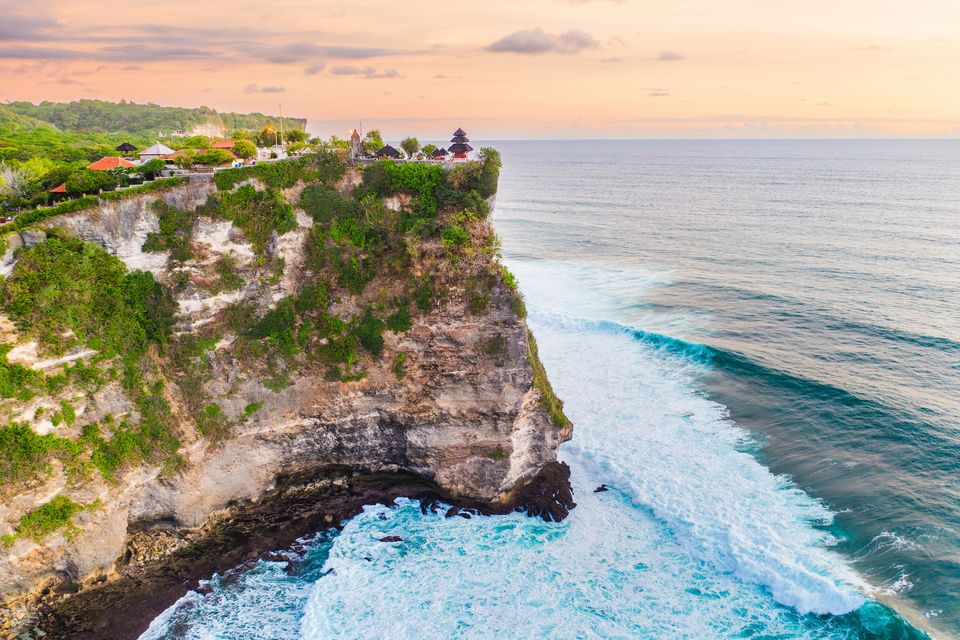Travel
The Bali beep – how to get the most out of your Indonesian adventure, from scooters to surf, snacks and roaming

Bali is a once-in-a-lifetime trip, but budget-friendly once you get there. JJ Clarke shares his tips…
I felt a mix of excitement and the unknown. This was my first trip to Bali, and the Southeast Asian island would prove different from any destination I’ve ever visited, from culture to cost.
Here are my top tips to get the most out of your trip.
Getting around
The traffic situation is a wonderful chaos. Drivers don’t react to signage or red lights, but somehow, it all seems to work. Masses of scooters move like a murmuration of birds at intersections - fluidly, unbothered by the helter-skelter situation.
You’ll soon get used to the ‘Bali beep’, too.
“In Bali, no one beeps in anger,” was something I heard often. It’s a short, sharp sound - the rider lets their finger slip over the button, so a millisecond of a noise is emitted. It means: “I’m coming up on your inside”; or: “Watch out, I’m about to overtake”.
Scooters in Canggu, Bali. Photo: Agunng Parameswara / Getty
Most hostels and hotels offer scooters that you can rent - most charge 100,000 Indonesian Rupiah (€5.70) per day. There are many ‘unofficial’ petrol stations where petrol is doled out in glass bottles; a full bottle will cost 20,000 (€1.14). Two bottles will last you two days in discovery mode.
Note that you need an international driver’s license to drive on the island, and this is not optional. As for taxis, a ride in a car is cheap but the back of a scooter is much cheaper. You can hail these on the Grab app, or Gojek and Maxim (the latter is the cheapest option, widely used by the Balinese).
Helmets are compulsory in Bali, even if you mightn’t believe it when you see a family of five crammed onto a tiny scooter. Most taxi drivers will offer a helmet (you can just select another driver if they don’t). A word of warning: tourists are more likely to get stopped by police for not wearing helmets than their Balinese counterparts. Even if you are the slowest and safest driver in the world, it pays to play it safe.
It can be both thrilling and terrifying to sit on the back of a scooter in full flight. This begs the question: “Do you hold on to the driver, or do you grab the little bar behind your bum?” I held on to the driver’s shoulders for dear life until midway through the trip when I felt confident enough to hold the bar behind me.
JJ surfing in Bali
Surf’s up
Soon after travelling to Bali, I met a friend and headed straight to Dreamland beach. Surfboard rental is standardised in Bali, so don’t be suckered by price. It is typically 50,000 Indonesian Rupiah (€2.88 for two hours).
If you are a beginner like us, Dreamland is a bit sketchy – the waves are enormous. The following day we made our way to Kuta beach, which is a beach break (sand rather than reef underfoot). The great thing about Bali is that you can get lessons for next to nothing – for €14, a surf instructor will do a one-on-one lesson with you for two hours, giving you advice on when to paddle, when to slow down, which way to turn and so on. An important note is to find an instructor with good English.
If surfing is your thing, Bali Back in Black surf school in Kuta is the place to go (Insta: @balibackinblack, but get your bookings in early as they are popular. Early one morning we took off at 6.30am sharp in a Balinese Jukung (a type of boat used for ferrying surfers). It dropped us about 200m out to sea off the airport runway with crystalline waves rolling in.
My instructor Wayan Tama had perfect English and was able to give excellent feedback - a truly unique experience. However, note that this is a reef break – one of the waves rolled me up pretty good and I ended up kicking the serrated corral. The other surfers informed me that my cuts were known as “Bali Tattoos”. Lime juice and antiseptic were the remedy.
For surfing information, checkout surfindonesia.com. This website gives you comprehensive breakdowns of all Bali’s beaches; from wave size to weather conditions and even the best times to avoid tourists. It’s an essential resource for a surfer.
Uluwatu Temple in Bali. Photo: Andrey Danilovich / Getty
A sunset dance
I’m a bit of a philistine when it comes to cultural appreciation. My preference is to meet people, focus on activities and not over-schedule.
However, the Kecak dance at Uluwatu Temple (about an hour south of Denpasar City) was worth it for me. Here, around 70 dancers reenact the Hindu religious story of Rama and Sita in a stone amphitheatre on the edge of a massive cliff. The dancers sing ”ke-cak-ke-cak” in various tones and harmonise with tremendous effect. The time to see this is at sunset with a mesmeriing backdrop.
Book on kecakdancebali.com – the whole experience will set you back around €11. My two cents? Prebook a priority ticket as the queueing system leaves a lot to be desired. Standing in the stultifying heat waiting for the previous show’s spectators to clear is avoidable.
Speaking of culture, it would be remiss of me not to mention the Balinese people – ever polite, smiling and chill. Sentences are often punctuated by laughter as if to invite you into their world, where your hectic European sense of time doesn’t matter. It’s refreshing to go to a place where English isn’t a given and the locals often thought I was from Iceland rather than Ireland.
Popular travel destinations often give off a ‘hate the tourists vibe’, but I didn’t feel this in Bali.
What to eat
Cuisine is where you’ll have a lot of fun in Bali. My recommendation? Nasi goreng. This is a delectable hodgepodge of rice, vegetables and some meat or prawns. A close second is Ayam Betutu - roast duck or chicken in a rich spicy sauce.
Then there is Bali coffee. A warning – this is unfiltered coffee with the bits left in. I didn’t like it, so look out for those commercial barista coffee machines in cafes if you want a ‘fancy’ coffee.
Rice paddies in Ubud
Yoga and waterfalls in Ubud
The final stop on my tour was the town of Ubud, a picturesque location known for its terraced rice patties, yoga and slower pace. I splashed on my last three nights and went for the most lavish hotel room. By this time, I had acclimatised to the low prices and was shocked to see its €28-per-night price tag. I then re-read the email receipt and realised it was €28 for the three nights.
All was well. Next, I visited the spectacular Tegenungan waterfall, where you can swim under it and grab a drink in the hotel beside.
Ubud is yoga central, and I went for a drop-in class at Intuitive Flow (intuitiveflow.com). The 90-minute class was €8.59 and was in a temple-like building with a view of a terraced valley.
Bartering and shopping
All supple after the yoga, I headed to the night market in Ubud where handmade furniture and masonry are the specialty. I was able to load up on presents for the family here, and I met a lady from Sydney who was filling a container with furniture and getting it shipped back home.
“I’m saving a bloody fortune,” she enthused.
A word on bartering in the markets: take the price first offered and divide it by four. This is not a hard and fast rule, but it worked well for me. The sellers buy at cost and are happy to engage in this verbal dance.
Where to stay
Hostels can be hit or miss in Bali, but they are cheap (there were days when the shower didn’t work, but sure that’s what the ocean is for).
I used booking.com while on the ground in Bali, changing when a hostel wasn’t up to scratch, and it worked seamlessly. You can go direct to the hotel/hostel – but the prices are so low that the margin that you will save is minimal. If you are going the hostel route and like the veneer of comfort, opt for a single room; the difference in price might be €5 for dorm rooms and €10 for a single room per night.
Indonesia was a Dutch colony up until 1949 but there are very few remnants of the past in this regard – or Dutch tourists for that matter. I met a lot of Russians, Germans and Australians on my travels.
Doni House and villas near Ubud can be found on booking.com and was sheer bliss. I highly recommend. It is built into a tiered valley and your bathroom looks out onto a steep ravine covered in forest. The houses are wooden – almost treehouse-like – but have all the modern creature comforts of air-con, fridge, TV and Netflix.
Bali weather and best time to travel
I like hot places and the weather was my style, but Bali’s climate may not be for everyone. The temperature was over 30 degrees every day I was there in May and, with high humidity, each day was a sticky one. May to October is Bali’s dry season and this is the best time to visit because you miss the monsoons from November to April.
The island is hilly too, so if you are thinking about elderly parents visiting, for example, you might like to warn them about the taxing heat. Bali’s dry season lasts from May to October and is the best time to take advantage of the island’s beauty.
Uluwatu Temple. Photo: JJ Clarke
Get there & visas
Before you transit customs, all tourists staying for up to 30 days in Bali must purchase a visa on arrival (VOA), which works out at €28. You pay this as soon as your feet hit the ground, even before you get your bag from the carousel. This can be paid by card or in cash. You can pay for VOA online at https://evisa.imigrasi.go.id, but there are a lot of scam websites out there so I think it’s better not to risk it and pay in person.
My advice for flights is to fly as directly as possible and avoid the spaghetti-junction-cheap ways of getting there. They may save you upfront but can cost you in terms of time and energy in the long-term.
The quickest routes from Ireland to Dublin is probably via Doha with Qatar Airways. You can also go via London, with a straight shot from there to Bali with Singapore Airlines.
Before you go, check out bali.com for information on transport, hotels and tourist attractions.
If you are a surfer and want to get into the weeds about different breaks and where to go, check out this article from surfer.com.
Using the internet
For internet access, I used Vodafone’s roaming for €5 extra a day for 500MB of data but this got pricey, and I was landed with a huge bill when I returned home – as some days, I exceeded my limit (you use maps on your phone for essentially everything). My friend was there for six weeks and bought an e-Sim for €20; this lasted him the entire time. He chose Telkomsel with 24GB.
Staring out the window of the plane home, I was left with a sense that there was more to be done – two weeks wasn’t enough to experience what this little island has to offer.
Bali’s brilliance requires time. I’ll give it more when I return next year.














